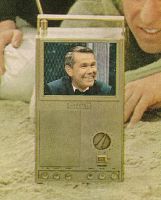 |
In May 1963, K.C. Kirkbridge dreams in the magazine Mechanix Illustrated about small TVs, miniature tape recorders and even about electronic computers in the size of a book. What drives all these reveries: the technology of the future of course - space travel. The problem: very limited cargo capacity. In order to be able to carry lots of stuff along, things have to become smaller (and lighter). Therefore, RCA works on the development of the first pocket TV. Unfortunately all details are strictly confidential. Or imaginary ... |




















